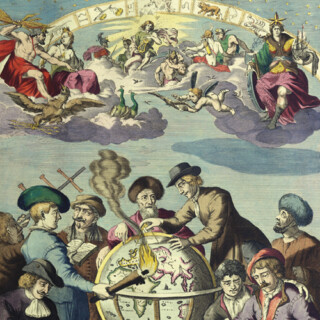Glossary of Terms for Collectors of Rare Maps, Atlases, Books, Globes and other related Scientific Objects.
The part of the endpapers that is pasted to the inside of the front and rear covers. French: Contreplat Photogravure is often characterized by photographic images that have moody, velvet-like black areas and a broad range of tone. Combining photography processes with traditional etching techniques, it allows the artist to print these photographic images on untreated printmaking papers. When tanned in the ordinary way, pigskin as a leather for binding, is intractable and, though very tough, liable to get brittle for lack of grease. When tawed with alum, it is much more tractable and very durable. It doesn't lend itself to decoration, except in blind. Danish: Svinesking A format of binding where full sheets of paper are gathered and bound unfolded, usually on their short (landscape) side. An illustration printed on a separate sheet of paper (usually heavy and better quality than the text pages) and added to the book during the binding process. This technique was developed in France in the early twentieth century. Translated “stencil,” this process allows the artist to directly add hand-coloured areas to an impression by painting these areas through a stencil. The stencil itself is usually knife-cut from thin-coated paper, paperboard, plastic, or metal and the ink or paint is applied with a brush. This technique is sometimes combined with other planographic methods, such as lithography. Navigational maps based on realistic descriptions of harbours and coasts. They were first made in the fourteenth century in Italy, Portugal and Spain. With the advent of the Age of Discovery, they were considered state secrets in Portugal and Spain, very valuable in the description of Atlantic and Indian coastlines for newcomer English and Dutch raiding, and later trading, ships. The word portolan comes from the Italian adjective portolano, meaning "related to ports or harbours." The copies of a book or other printed material that originates from the same press run or from the same plates or setting of type at one time. In the example given for "Edition", the 500 copies would be the first printing and the 300 copies comprise the second printing. This term generally refers to any impression pulled before the official printed edition of an image or book. The artist or printer may make changes to the image after examining a proof, much like an author makes changes to a rough draft of a manuscript before sending it to the publisher. Once the image is the way the artist wants it to be, it will be the model for the finished edition. Printed material, often in the form of a leaflet or broadside, which describes a forth-coming title in detail, often including information on ordering the book including pre-publication price. Evidence of the history of the ownership of a particular item (e.g.: auctions records, booksellers' records, book plates, etc.) The item may be important because of who owned it; perhaps a president or important bookseller, collector, royalty, or someone who may be related to the book in some way. Danish: Berømt proveniens
Glossary
P
Pastedown endpapers
Pastedown endpapers
German: Innenspiegel
Photogravure
Photogravure

Pigskin
Pigskin
Dutch: Varkensleer
French: Peau de truie
German: Schweinsleder
Italian: Pelle di troia, di scrofa
Spanish: Piel de cerdo
Swedish: Svinläder
Plano
Plano

Plate
Plate

Pochoir
Pochoir
Portolan charts
Portolan charts

Printing
Printing

Proof
Proof

Prospectus
Prospectus
Provenance
Provenance
Dutch: (Beroemde) herkomst
French: Provenance
German: Provenienz
Italian: Provenienza
Spanish: Procedencia illustre
Swedish: Proveniensexemplar







